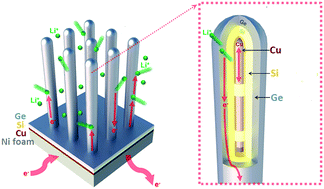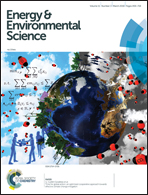Harnessing the concurrent reaction dynamics in active Si and Ge to achieve high performance lithium-ion batteries†
Abstract
Advanced composite electrodes containing multiple active components are often used in lithium-ion batteries for practical applications. The performance of such heterogeneous composite electrodes can in principle be enhanced by tailoring the concurrent reaction dynamics in multiple active components for promoting their collective beneficial effects. However, the potential of this design principle has remained uncharted to date. Here we develop a composite anode of Cu/Si/Ge nanowire arrays, where each nanowire consists of a core of Cu segments and a Si/Ge bilayer shell. This unique electrode architecture exhibited a markedly improved electrochemical performance over the reference Cu/Si systems, demonstrating a stable capacity retention (81% after 3000 cycles at 2C) and doubled specific capacity at a rate of 16C (1C = 2 A g−1). By using in situ transmission electron microscopy and electrochemical testing, we unravel a novel reaction mechanism of dynamic co-lithiation/co-delithiation in the active Si and Ge bilayer, which is shown to effectively alleviate the electrochemically induced mechanical degradation and thus greatly enhance the long-cycle stability of the electrode. Our findings offer insights into a rational design of high-performance lithium-ion batteries via exploiting the concurrent reaction dynamics in the multiple active components of composite electrodes.



 Please wait while we load your content...
Please wait while we load your content...